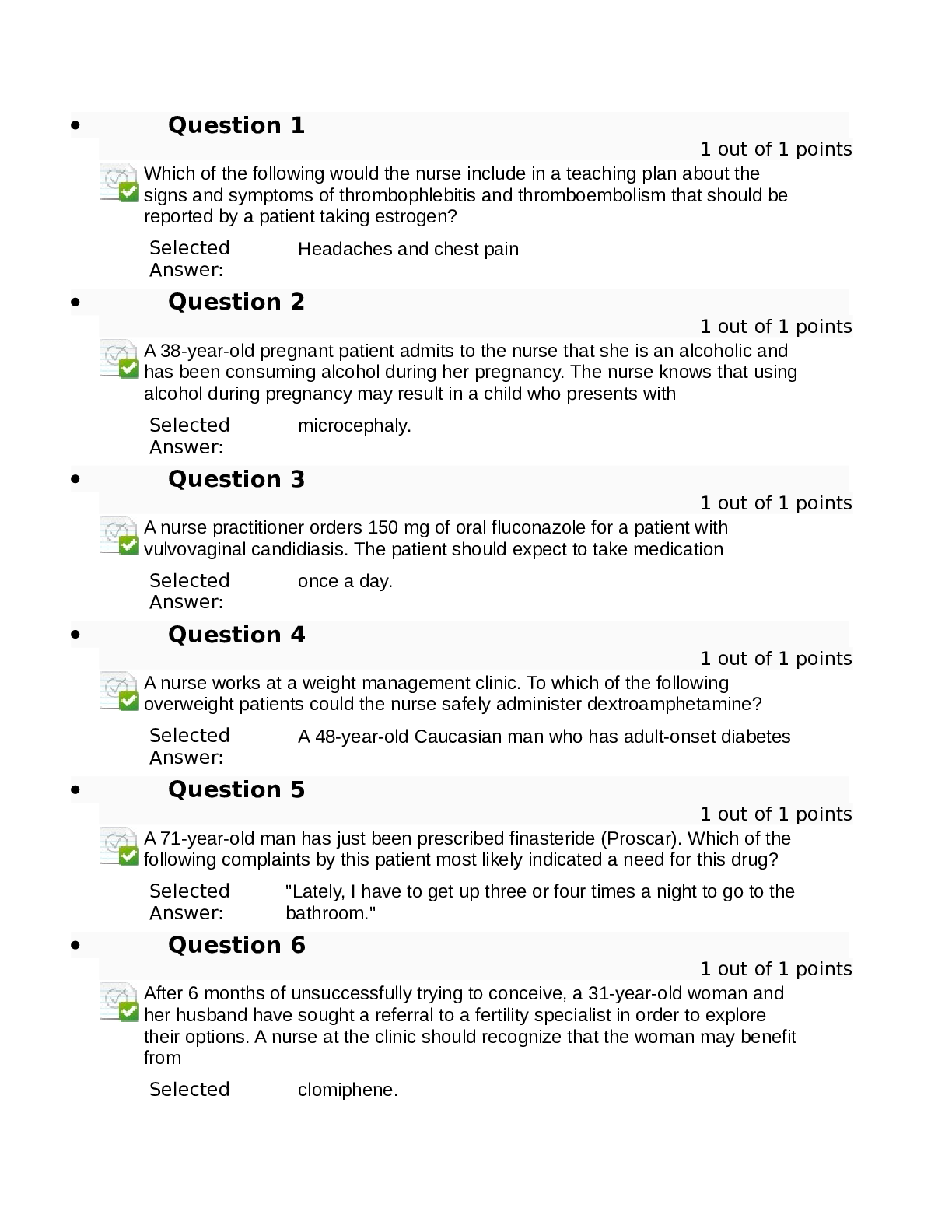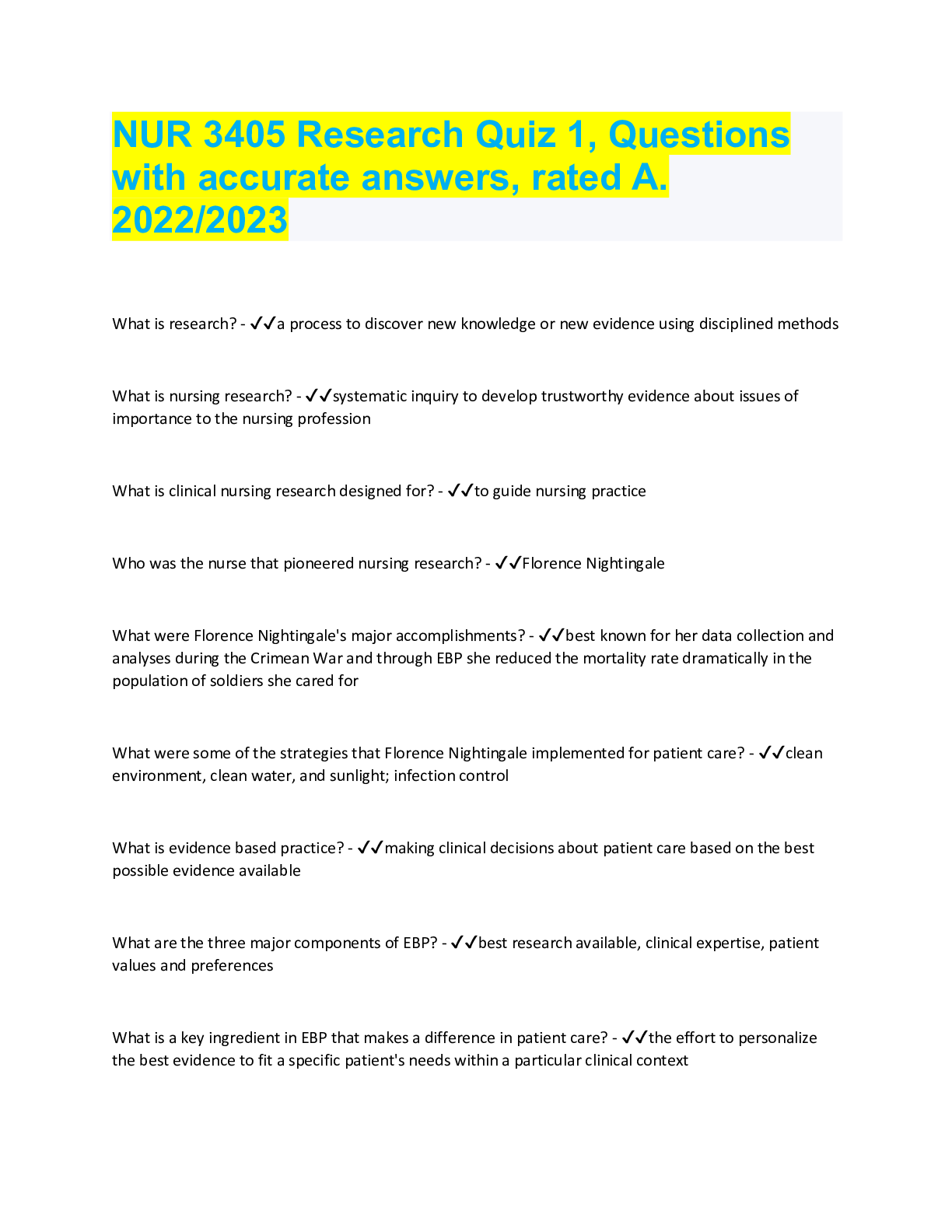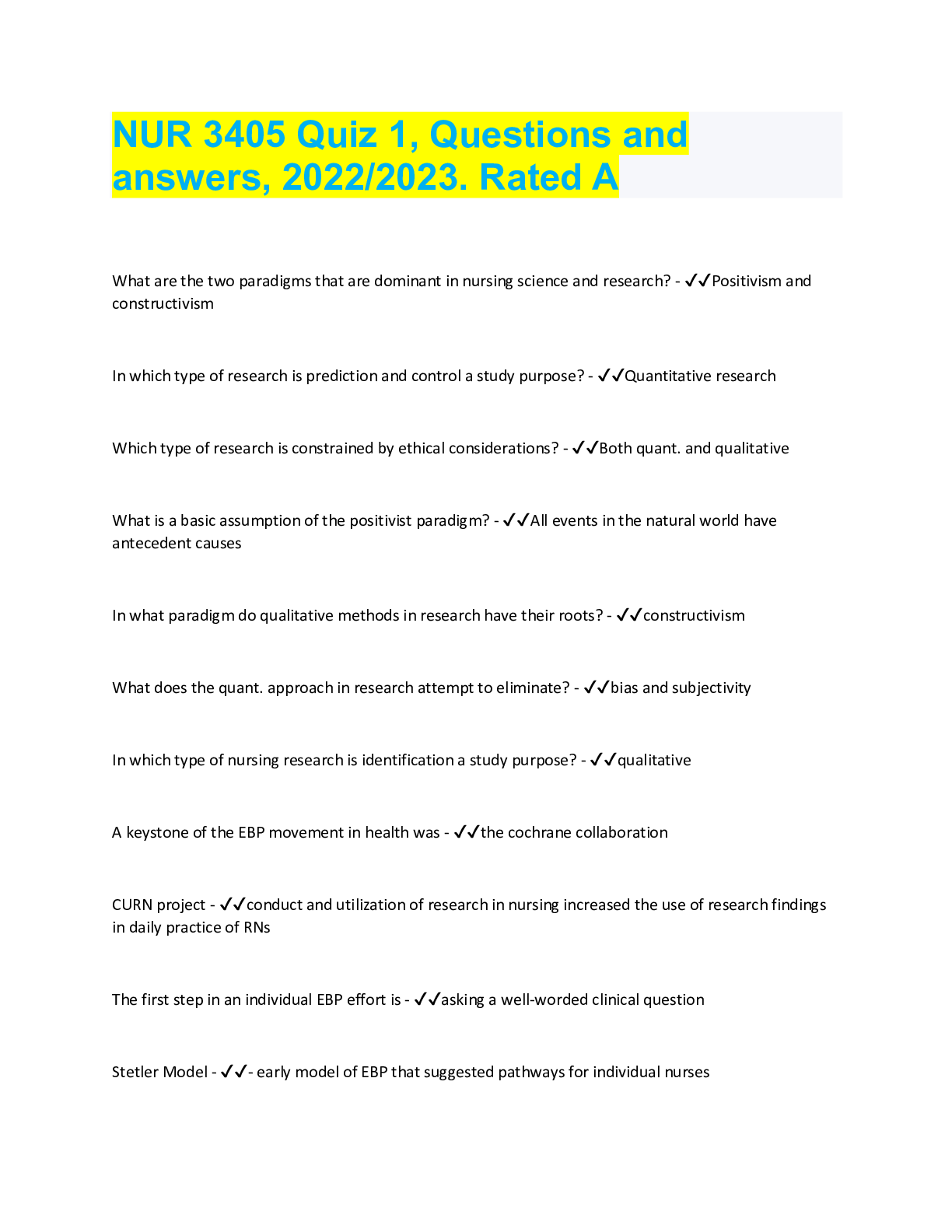*NURSING > QUESTIONS & ANSWERS > WALDEN UNIVERSITY NURS 6521N, QUIZ 1, QUESTIONS AND ACCURATE ANSWERS,.DOWNLOAD TO SCORE HIGH (All)
WALDEN UNIVERSITY NURS 6521N, QUIZ 1, QUESTIONS AND ACCURATE ANSWERS,.DOWNLOAD TO SCORE HIGH
Document Content and Description Below
• Question 1 1 out of 1 points A nurse is instructing a patient concerning a newly prescribed drug. Which of the following should be included to help improve patient compliance and safety? R... esponse Feedback: If patients are aware of certain adverse effects and how to alleviate or decrease the discomfort, they are more likely to continue taking the medication and providing for safe administration. A list of pharmacies can be useful information, but will not improve safety or compliance. Knowing the cost of the brand versus the generic could also be helpful to the patient. However, a substitution may not be allowed, and the cost of a drug does not improve patient safety. Most patients are not concerned with statistics regarding drug testing, and the testing is usually not discussed with patients. • Question 2 1 out of 1 points An unconscious patient has been brought to the hospital, and the physician has prescribed a lifesaving drug to be administered parenterally. Which of the following methods would be the most appropriate for the nurse to use when administering the medication? Response Feedback: Intravenous infusion is the preferred method for use in emergency situations when rapid drug effects are desired. Absorption is considered to be instantaneous, as the drug is placed directly into the bloodstream. The subcutaneous and intramuscular routes could be used but would not ensure rapid drug effects. Intrathecal administration is usually done by a physician or a specially trained health care provider. • Question 3 0 out of 1 points In response to a patient's nausea, the nurse has mixed a dose of an antiemetic with 50 mL of sterile normal saline and will administer the dose by IV piggyback. What is the rationale for the use of IV piggyback? Response Feedback: When the patient receives continuous IV fluids and is also receiving intermittent IV drug therapy, the drug is normally given through a secondary IV tubing. When a secondary IV tubing is used to administer an IV drug, the tubing is added to the main line tubing, usually at a Y port. Adding secondary tubing is called “piggybacking” because the tubing with the drug rides on top of the primary fluid tubing. Failure to adhere to a prescribed regimen, unstable electrolyte levels, and need for continuous monitoring are not rationales for the use of an IV piggyback. • Question 4 1 out of 1 points During a clinic visit, a patient complains of having frequent muscle cramps in her legs. The nurse's assessment reveals that the patient has been taking overthecounter laxatives for the past 7 years. The nurse informed the patient that prolonged use of laxatives Response Feedback: Longterm intake of laxatives, antidepressants, and antibiotics has been found to deprive a person of most essential nutrients, such as vitamins. Prolonged use of laxatives is not known to turn urine acidic, cause urinary tract infections, counter the effect of other drugs, or inhibit the biotransformation of drugs. • Question 5 1 out of 1 points A 60yearold AfricanAmerican man lives with a number of chronic health problems. Genetic factors are likely to influence his etiology and/or treatment of Response Feedback: The incidence of hypertension is significantly higher among AfricanAmericans than other ethnic groups. As well, African Americans respond to some antihypertensive drugs differently than whites. • Question 6 1 out of 1 points A nurse is caring for a patient who has had part of her small intestine removed due to cancer. She has also now developed hypertension and has been prescribed a new medication to decrease her blood pressure. While planning the patient's care, the nurse should consider a possible alteration in which of the following aspects of pharmacokinetics? Response Feedback: Because absorption takes place mostly in the small intestine, there could be possible alterations with this process. Distribution takes place in the blood vessels; metabolism in the liver; and elimination via the kidneys. Because these systems are not affected by her surgery, these phases of pharmacokinetics would not be altered. • Question 7 1 out of 1 points Talwin given in combination with Vistaril diminishes the adverse effects of nausea caused by the Talwin. This drug interaction affecting the pharmacodynamics of the Talwin is Response Feedback: An antagonistic drug interaction results in a therapeutic effect that is less than the effect of either drug alone because the second drug either diminishes or cancels the effects of the first drug. An additive effect occurs when two or more “like” drugs are combined and the result is the sum of the drugs' effects. A synergistic effect occurs when two or more “unlike” drugs are used together to produce a combined effect and the outcome is a drug effect greater than either drug's activity alone. Potentiation is an interaction in which the effect of only one of the two drugs is increased. • Question 8 1 out of 1 points Which of the following statements best defines how a chemical becomes termed a drug? Response Feedback: Even though all the responses are correct, a chemical must undergo a series of tests to determine its therapeutic value and efficacy without severe toxicity or damaging properties before it is termed a drug. Test results are reported to the FDA, which may or may not give approval. • Question 9 1 out of 1 points An older adult patient with a history of Alzheimer's disease and numerous chronic health problems has been prescribed several medications during his current admission to hospital and recent declines in the patient's cognition have impaired his ability to swallow pills. Which of the following medications may the nurse crush before administering them to this patient? Response Feedback: A tablet that is designed for immediate release into the gastric environment is normally safe to crush and administer to the patient. Enteric coated and sustained release tablets may not be crushed because doing so compromising the delayed release into the GI tract that is intended with these medications. Sublingual medications should be placed under the tongue to dissolve rather than swallowed. • Question 10 1 out of 1 points A nurse is caring for a patient who has recently moved from Vermont to south Florida. The patient has been on the same antihypertensive drug for 6 years and has had stable blood pressures and no adverse effects. Since her move, however, she reports “dizzy spells and weakness” and feels that the drug is no longer effective. The nurse suspects that the change in the effectiveness of the drug is related to Response Feedback: Antihypertensive drugs work to decrease blood pressure. When a patient goes to a climate that is much warmer than usual, blood vessels dilate and the blood pressure decreases. If a patient is taking an antihypertensive drug and enters a warmer climate, there is a chance that the patient's blood pressure will drop too low, resulting in dizziness and a feeling of weakness. After several years on an antihypertensive drug, the effects of that drug are known; therefore, the placebo effect should not be an issue. Most antihypertensives are metabolized and excreted and do not accumulate in the body. The patient has not given the nurse any information that would indicate that she has not been compliant with her drug [Show More]
Last updated: 2 years ago
Preview 1 out of 12 pages
.png)
Buy this document to get the full access instantly
Instant Download Access after purchase
Buy NowInstant download
We Accept:

Reviews( 0 )
$10.00
Can't find what you want? Try our AI powered Search
Document information
Connected school, study & course
About the document
Uploaded On
Mar 19, 2022
Number of pages
12
Written in
Additional information
This document has been written for:
Uploaded
Mar 19, 2022
Downloads
0
Views
116

.png)
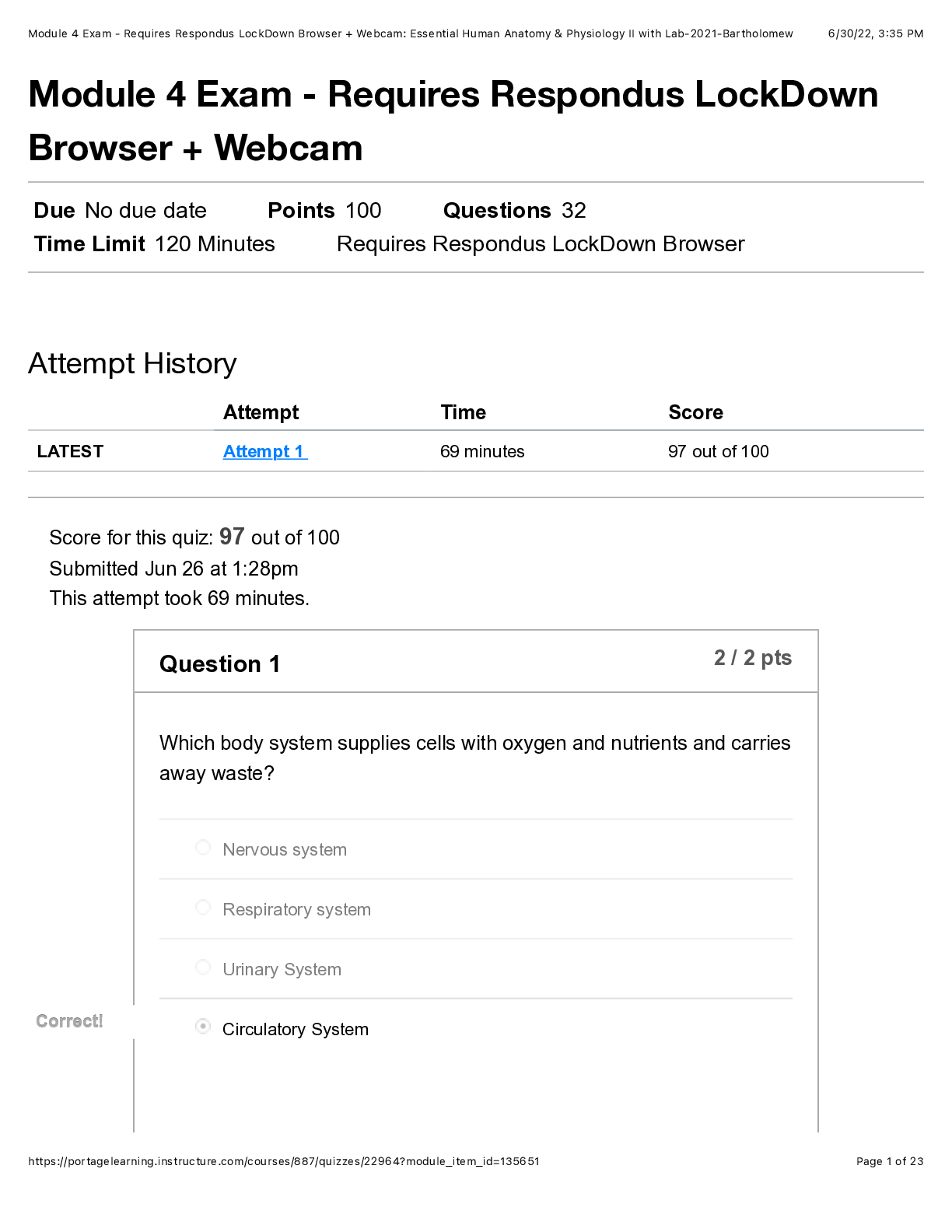






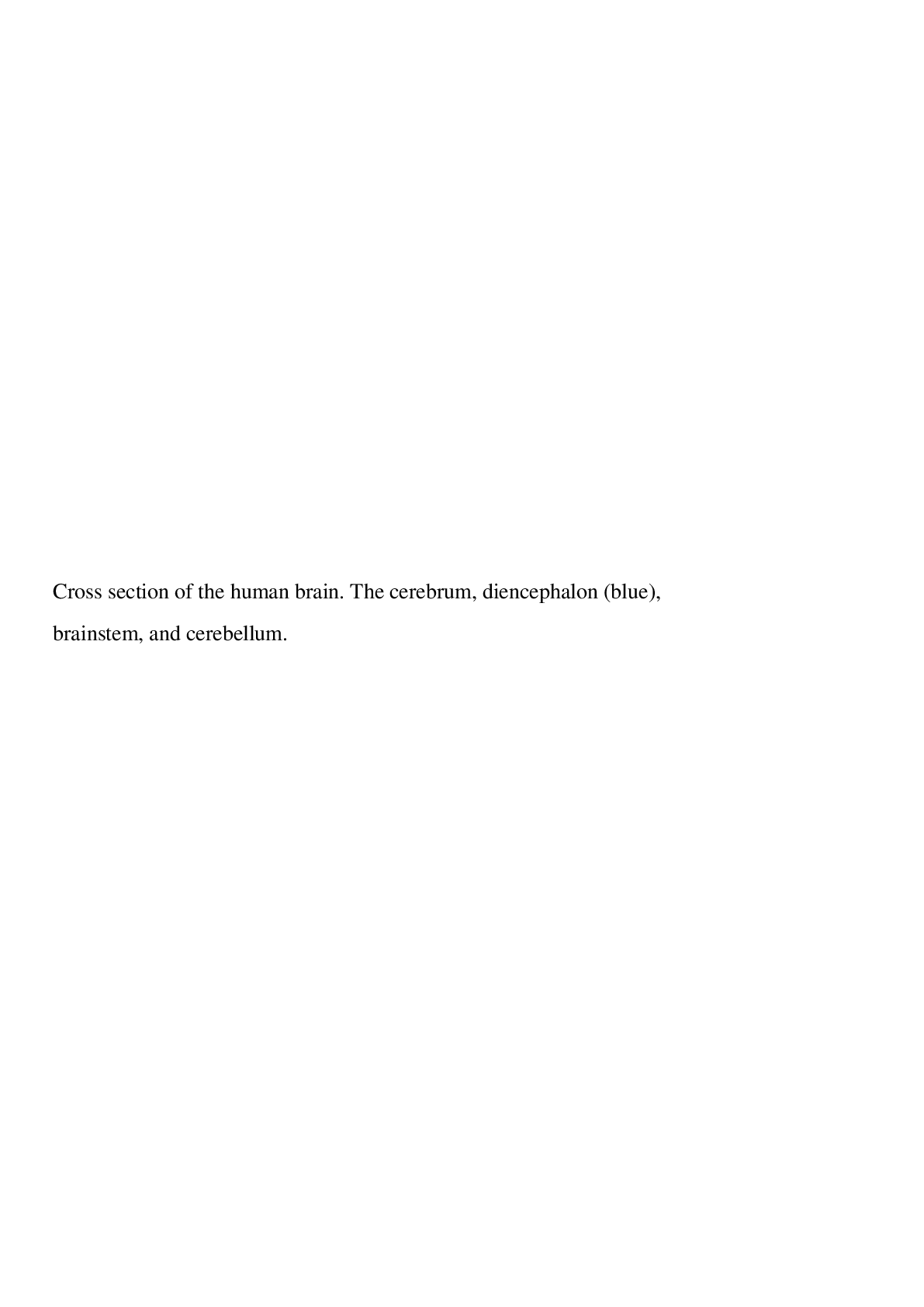

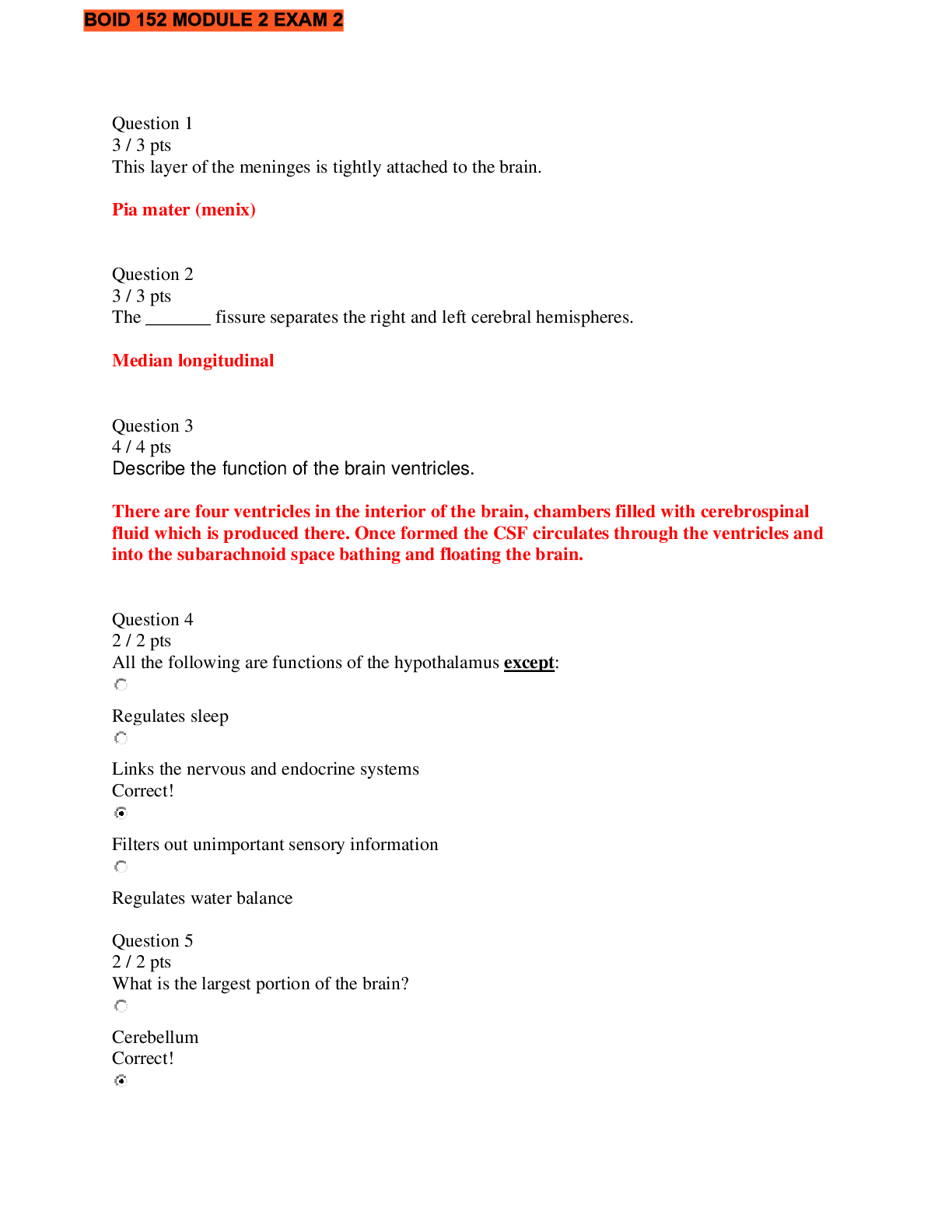


.png)
